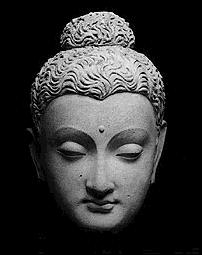
![]()
What is Buddha's Teaching and Philosophy
Throughout the living life of the Buddha, he taught many things, but the basic concepts in Buddhism can be summed up by the Four Noble Truths and the Noble Eightfold Path. Buddhists called it The Dhamma.
However, many of his concept of 'way of life' philosophy are to be found in hundreds of sutras (religious text) which may be relevant and also irrelevant in the design thesis. However for the first part of the crit I shall present the basic teachings and philosophies.
The Four Noble of Truth
After his enlightenment that achieve a remarkable insight into the human condition, The Buddha set forth to teach the Dhamma and had his first sermon known as 'The Discourse of the Setting in Motion of the Wheel of the Doctrine' (the birth of Buddhism) in Sarnath. The Buddha explained the human condition in terms of a framework called the Four Noble of Truth. The doctrine can be an unending study research that revolves around the logical process of seeing life, seeing all actions, not as one wish to see them, but as they really are. In brief explanation :
Noble
Truth 1: There is suffering. (Or more precisely, cravings)
Noble Truth 2: There is a cause of suffering. That cause is desire and
attachment.
Noble Truth 3: There is a way to eliminate the suffering, which is to
eliminate the cause.
Noble Truth 4: The way leading to the elimination of suffering is the
eightfold noble path.
The first truth is that life is suffering, life includes pain, getting old, disease, and ultimately death. Apart from physical body, the emotion also endure psychological suffering like loneliness frustration, fear, embarrassment, disappointment and anger. This is an irrefutable fact that cannot be denied. It is realistic rather than pessimistic, instead, Buddhism explains how suffering can be avoided and how to be truly happy.
The second noble truth is that suffering has a cause. Suffering occurs because of ignorance (cravings, desires, attachment, aversions etc.) and constantly struggling to survive, trying to prove the existence. Even though the act of extremely humble and self-depreciating, but even that is an attempt to define one selves and preserve humility. The harder the struggle to establish one selves and relationships (worldly cause), the more painful the experience becomes. Ignorance leads to physical suffering because it creates a powerful energy that cause reborn.
The third truth is that suffering can be overcome and happiness can be attained; that true happiness and contentment are possible. The struggle to survive, the effort to prove existence and solidify worldly relationships is unnecessary. By giving up useless craving and learn the dhamma to live each day at a time (not dwelling in the past or the imagined future) then the cause is eliminated. Nibbana can be attained.
The fourth truth is that the Noble 8-fold Path (the middle way) is the path which leads to the end of suffering. The central theme of this way is meditation. Meditation, here, means the practice of mindfulness/awareness, shamata/vipashyana in Sanskrit. It is the practice of being mindful of all the things that are used to torture one selves with. By becoming mindful and by abandoning the expectations about the way things should be and, out of the mindfulness, then the development of awareness about the way things really are begin.
The Noble 8 fold Path
The Noble 8 Fold Path is the Middle Way of self -conquest which leads to a complete cessation of suffering. In summary, the Noble 8-fold Path is being moral (through what one say, do and the livelihood), focusing the mind on being fully aware of our thoughts and actions, and developing wisdom by understanding the Four Noble Truths and by developing compassion for others. In brief:
RIGHT UNDERSTANDING meaning the right way to understand the world and the knowledge of the Four Noble of Truth so that one is able to understand things as they really are to eliminate ignorance.
RIGHT THOUGHT (Intention) means developing the noble qualities of love and the aversion to cause hurt to other. It starts from right understanding for the intentions to be pure.
RIGHT SPEECH is to abstain from lying, idle-talk, slander and harsh words for if the intentions are pure, one say what needs to be said in a genuine way.
RIGHT ACTION is to abstain from taking life, taking what is not given and sexual misconduct. With the right understanding and thought, one only have simple approach to the environment.
RIGHT LIVELIHOOD means to avoid deliberately harming others or means to earn a living in a harmful or unkind way that is vast to be precise. For with the intention is clear, then the right livelihood will be developed.
RIGHT EFFORT means cultivating an enthusiasm, a positive attitude in a balanced way that requires assiduous self discipline to attain full control of the mind. Right effort doesn't involve struggle at all after the morality of speech, action and livelihood.
RIGHT MINDFULNESS means developing full awareness of all actions of the body, speech and mind at every moment, focused at every moment to be clear and undistracted. It allow nothing to happen heedlessly or mechanically that may turn up into an unwholesome act.
RIGHT
CONCENTRATION is to attain mental quietude and the wisdom to realize the
full significance of the world. It implies that only select worthy
directions for the concentration of the mind, although everything in
nature, beautiful and ugly, may be useful for concentration. It teach the
mind to see things, not as one is conditioned to seeing them, but as they
really are. At the same time, it also leads to a feeling of calm and peace
with the world. By being in the moment and being able to concentrate
effectively, a sense of joy in the moment is felt. Release from the
control of past pains and future mind games takes one closer to freedom
from suffering.
The Noble 8-fold Path can be summarized to 3 category:
Panna ( the head or wisdom)- Right Understanding, Right Thoughts
Sila (the body or morality) - Right Action, Right Speech, Right Livelihood
Samadhi (the heart)- Right Effort, Right Mindfulness, Right Concentration
Practicing Panna, ignorance, cravings and desires shall be eliminated by the Truth. When the Truth is clear, one would take simple approach to the environment by practicing Sila to live in a way that is a blessing rather than harm. Panna and Sila work together in a perfect harmony. But still it concerns only to the physical body. One would be practicing Samadhi to live in the balanced emotional serenity mind. Hence with the practicing of the Noble 8-fold Path, the three are integrated, working together for realization and supporting each other, not one is dominating the other or rejecting anything to achieve peacefulness, stillness, knowing, Nibbana.
Look at the picture of the emotion of Buddha who practiced the Panna, Sila, and Samadhi.
[I am trying to my best to use simple words (not too long) to communicate though this is my understanding of the philosophy (mostly in long story forms) but haven't achieve it. If there is some that lacks understanding I'll try my best to explain the story when asked. However, I am still troubled by the relevancy of so many materials to the design thesis]
Previous Next
![]() This
is a thesis website by ressox studio.
This
is a thesis website by ressox studio.

